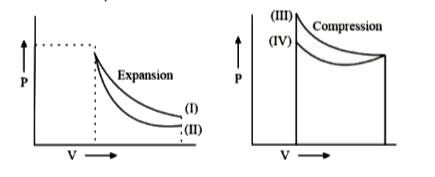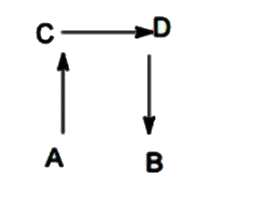Complete Solutions to SINGLE CHOICE of chapter THERMODYNAMICS TEST-1 of Class 12 book with complete answers and questions
| Class 12 | CHEMISTRY |
| Chapter | THERMODYNAMICS TEST-1 |
| NTA MOCK TESTS | SINGLE CHOICE |
| Number Of Questions | 30 |
| Academic Year | 2023-24 |
The S - S bond energy, if
`DeltaH_(f)^(@) (E_(t) - S - E_(t)) = -147` mol, and `DeltaH_(f)^(@) (E_(t) - S - S - E_(t)) = -202` kJ/mol
`DeltaH_(f)^(@) S (g) = +233` kJ/mol, is:
View SolutionThe lattice energy of solid NaCl is 180 kcal/mol. The dissolution of the solid in water in the form of ions is endothermic to the extent of 1 kcal/mol. If the hydration energies of `Na^(+)` and `Cl^(-)` are in the ratio `6: 5`, what is the enthalpy of hydration of Nation ?
View SolutionDiborane is a potential rocket fuel which undergoes combustion according to the reaction:
`B_(2)H_(6)(g) + 3O_(2)(g) to B_(2)O_(3) (s) + 3H_(2)O (g)`
From the following data, calculate the enthalpy change for the combustion of diborane.

View Solution2 mol of an ideal gas at 27°C temperature is expanded reversibly from 2 L to 20 L. Find the entropy change. (R = 2 cal / mol K)
View SolutionThe enthalpy of neutralisation of `NH_4OH` and `CH_3COOH` is -10.5 kcal `"mol"^(-1)` and enthalpy of neutralisation of `CH_3COOH` with strong base is -12.5 kcal `"mol"^(-1)`. The enthalpy of ionisation of `NH_4OH` will be:
View SolutionThe enthalpy of hydrogenation of cyclohexene is `-119.5 "kJ mol"^(-1)`. If resonance energy of benzene is `-150.4 "kJ mol"^(-1)` its enthalpy of hydrogenation would be
View SolutionThe bond dissociation energies of gaseous `H_2, Cl_2` and HCl are 104, 58 and 103 kcal, respectively. The enthalpy of formation of HCl gas would be:
View SolutionThe change in entropy of 2 moles of an ideal gas upon isothermal expansion at 243.6 K from 20 L to the state where pressure becomes 1 atm is (Given: In 2 = 0.693)
View SolutionThe work done in an open vessel at 300 K, when 112 g iron reacts with dil. HCl is:
`(R = 2 "cal mol"^(-1) K^(-1))`
View SolutionAt 1000 K, from the data,
`N_(2)(g) + 3H_(2)(g) to 2NH_(3) (g), Delta_(r) H^(@) = - 123.77 "kJ mol"^(-1)`

The heat of formation of ammonia in `"kJ mol"^(-1)` at 300 K is:
View SolutionEnthalpy of atomization of `C_(2)H_(6) (g)` and `C_(3)H_(8) (g)` are 620 and `880 kJ "mol"^(-1)` respectively. The C-C and C-H. bond energies are respectively.
View SolutionOn the basis of the following thermochemical data:
`[Delta_(f) H^(@) " of " H^(+) (aq) =0]`
`H_(2)O (l) to H^(+) (aq) + OH^(-) (aq) , DeltaH^(@) = 57.32 kJ`
`H_(2)(g) + 1/2 O_(2) (g) to H_(2)O (l), DeltaH^(@)= - 286.02` kJ
What is the value of enthalpy of formation of `OH^(-)` at 25°C?
View SolutionThe free energy change for the following reactions are given below:
`C_(2)H_(2) (g) + 5/2 O_(2)(g) to 2CO_(2)(g) + H_(2)O(l)`,
`DeltaG^(@) = -1234` kJ
`C(s) + O_(2)(g) to CO_(2)(g)`,
`DeltaG^(@) = -394` kJ
`H_(2) (g) + 1/2 O_(2) (g) to H_(2)O(l)`,
`DeltaG^(@) = -237` kJ
What is the standard free energy change for the following reaction?
`H_(2)(g) + 2C(s) to C_(2)H_(2)(g)` ?
View Solution1 mole of `H_(2)SO_(4)` is mixed with 2 moles of NaOH. The heat evolved will be:
View SolutionThe enthalpy of combustion of `H_(2)`, cyclohexene (`C_(6)H_(10)`) and cyclohexane (`C_(6)H_(12)`) are `-241, – 3800` and `- 3920 kJ "mol"^(-1)` respectively. The heat of hydrogenation of cyclohexene is:
View SolutionThe heat of atomisation of `PH_3` (g) is 228 kcal `"mol"^(-1)` and that of `P_2H_4` (g) is 335 kcal `"mol"^(-1)`. The energy of P-P bond is:
View SolutionAt what minimum pressure (in terms of kPa) of given volume of an ideal gas (`C_(p.m) = 7/2 R`), originally at 400 K and 100 kPa pressure, be irreversibly adiabatically compressed in order to raise its temperature to 600 K?
View Solution16 g oxygen gas expands at STP to occupy double of its original volume. The magnitude of work done during the process is:
View SolutionCalculate the enthalpy change when 50 mL of 0.01 M `Ca(OH)_2` , reacts with 25 mL of 0.01 M HCl. Given that, AH° of neutralization of a strong acid and a strong base is 140 kcal `"mol"^(-1)`.
View SolutionIf `Delta_(f) H^(@) (C_(2)H_(4))` and `Delta_(f) H^(@) (C_(2)H_(6))` are a and b `"kcal mol"^(-1)`, then, the heat of hydrogenation of `C_2H_4` IS:
View SolutionThe enthalpies of neutralization BOH and a strong base BOH by HCl are – 12250 cal / mol and - 13000 cal / mol respectively. When one mole of HCl is added to a solution containing 1 mole of AOH and 1 mole of BOH, the enthalpy change was - 12500 cal / mol. In what ratio is the acid distributed between AOH and BOH respectively.
View SolutionIn the conversion of limestone to lime, `CaCO_3 (s) + CaO (s) + CO_2` (g), the values of `DeltaH^(@)` and `DeltaS^(@)` are `179.1 "kJ mol"^(-1)` and `160.2 JK^(-1) "mol"^(-1)` respectively at 298 K and 1 bar. Assuming `DeltaH^(@)` and `DeltaS^(@)` remain constant with temperature, at which minimum temperature does the conversion of limestone to lime will be spontaneous ?
View SolutionFor an ideal gas, `(C_("p.m"))/C_("v.m") = gamma`. The molecular mass of a gas is M, its specific heat capacity at constant volume is:
View SolutionWhich of the figures given below show the adiabatic process ?

View SolutionThe value of `log_10` K for a reaction `A to B` is Given: `Delta_(r) H_(298 K)^(@) = -54.07 kJ "mol"^(-1)`,
`Delta_(r) S_(298 K)^(@) = 10 JK^(-1) "mol"^(-1)`
`R = 8.314 JK^(-1) "mol"^(-1)`
`2.303 xx 8.314 xx 298 = 5705`
View SolutionThe direct conversion of A to B is difficult, hence, it is carried out by the following path:

Given:
`DeltaS_(A to C) = 50` c.u,
`DeltaS_(C to D) = 30` c.u.
`DeltaS_(B to D) = 20` c.u where e.u is the entropy unit.
Then, `DeltaS_(A to B)` is:
View SolutionIf `DeltaH` is the change in enthalpy and `DeltaE`, the change in internal energy accompanying a gaseous reaction, then:
View SolutionOne mole of an ideal gas at 300 K is expanded isothermally from an initial volume of 1 litre to 10 litre. `DeltaE` for this process is:
(R = 2 cal `"mol"^(-1) K^(-1)`)
View SolutionThe heat of formation of methane at constant pressure is 18500 Kcal at 25°C. What would be the heat of reaction at constant volume?
(Given: `C(s) + 2H_2 + CH_4 + 18500` kcal, `Q_p = 18500` cals, R = 2 kcal,
`Q_p` = Heat of reaction at constant pressure)
View SolutionThe work done (in erg) for the reversible expansion of one mole of an ideal gas from a volume of 10 Litres to 20 Litres at 25°C is:
View Solution
SINGLE CHOICE questions and complete solutions for chapter THERMODYNAMICS TEST-1 of NTA MOCK TESTS of Class 12